Standard and Metric Wrench Sizes and Socket Sizes | SAE to Metric Conversion | Wrench and Socket Sizes in Order: I used to have all of the SAE standard wrench and socket sizes in order memorized and could tell you instantly what size was next in order from small to large and which metric socket or wrench was equivalent. That was decades ago, back in my days as a mechanic and industrial technician.
SAE Standard and Metric Wrench Sizes
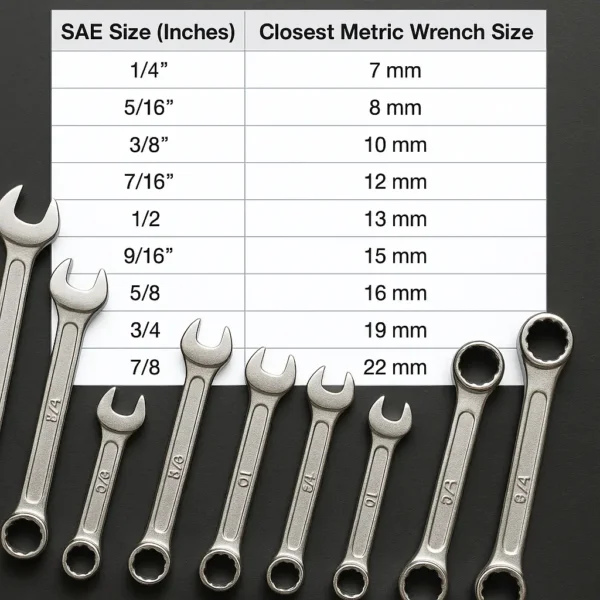
Easily convert wrench and socket sizes from SAE to metric:
This post includes a printable standard wrench size chart, a bolt to wrench size chart, an interactive wrench size calculator, comprehensive drive size recommendations, mention of what size torque wrench to use for differing applications, and a SAE to metric conversion video
Over the years, I've completely forgotten where some of the most common box end, open end wrench and socket sizes fit in. After a quick search yielding no real good results containing all of this information, I've decided to create a reference SAE (inches) + Metric (mm) page and size chart for myself and others to refer to. So without further ado, here are the results.
Take 7/16" and 9/16" for example; two of the most frequently used sizes in automotive work. The 7/16" wrench fits common 1/4"-20 bolts, while the 9/16" wrench is standard for 3/8"-16 bolts. Back in the day, I used these so often that I could grab them blindfolded. But over time, those size to bolt relationships start to fade from memory, which is exactly why I decided to put together a comprehensive chart.
Wrench Sizes - SAE to Metric Conversion
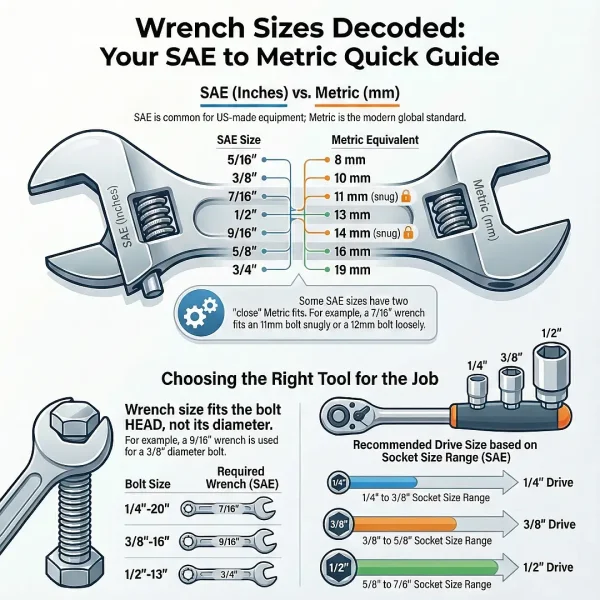
SAE to Metric Conversion Chart
Standard Wrench Sizes Chart with SAE to Metric Conversions: The following chart lists the most common standard wrench and socket sizes, including their corresponding sizes one step smaller and larger, as well as the metric equivalents. For easy reference, you can also download the Wrench Sizes in Order - SAE Size and Metric Equivalent Conversion Chart as a PDF file.
📄 Print this wrench size chart to keep in your toolbox, garage, or glovebox.
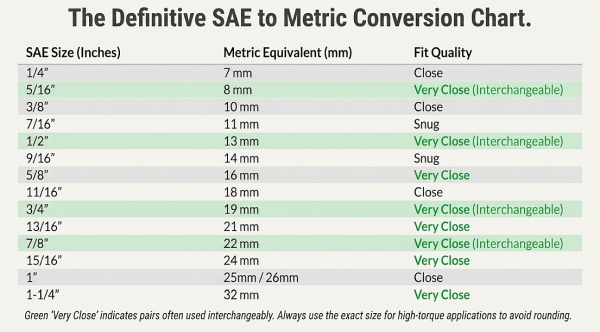
SAE and Metric Sizes Compared in Ascending Order
The following shows standard SAE sizes in the left column, previous and next SAE size in the middle columns, and the closest metric equivalent size on the far right.
| SAE Size (Inches) | Previous Size | Next Size | Metric Equivalent |
|---|---|---|---|
| 1/4" | ' | 5/16" | 7 mm |
| 5/16" | 1/4" | 3/8" | 8 mm |
| 3/8" | 5/16" | 7/16" | 10 mm |
| 7/16" | 3/8" | 1/2" | 11 mm (snug) 12 mm (loose) |
| 1/2" | 7/16" | 9/16" | 13 mm |
| 9/16" | 1/2" | 5/8" | 14 mm (snug) 15 mm (loose) |
| 5/8" | 9/16" | 11/16" | 16 mm |
| 11/16" | 5/8" | 3/4" | 18 mm |
| 3/4" | 11/16" | 13/16" | 19 mm |
| 13/16" | 3/4" | 7/8" | 21 mm |
| 7/8" | 13/16" | 15/16" | 22 mm |
| 15/16" | 7/8" | 1" | 24 mm |
| 1" | 15/16" | 1 1/16" | 26 mm |
| 1 1/16" | 1" | 1 1/8" | 27 mm |
| 1 1/8" | 1 1/16" | 1 1/4" | 29 mm |
| 1 1/4" | 1 1/8" | 1 5/16" | 32 mm |
| 1 5/16" | 1 1/4" | 1 3/8" | 34 mm |
| 1 3/8" | 1 5/16" | 1 7/16" | 35 mm |
| 1 7/16" | 1 3/8" | 1 1/2" | 37 mm |
| 1 1/2" | 1 7/16" | 1 9/16" | 39 mm |
| 1 9/16" | 1 1/2" | 1 5/8" | 40 mm |
| 1 5/8" | 1 9/16" | 1 11/16" | 42 mm |
| 1 11/16" | 1 5/8" | 1 3/4" | 43 mm |
| 1 3/4" | 1 11/16" | 1 13/16" | 45 mm |
| 1 13/16" | 1 3/4" | 1 7/8" | 47 mm |
| 1 7/8" | 1 13/16" | 1 15/16" | 48 mm |
| 1 15/16" | 1 7/8" | 2" | 50 mm |
| 2" | 1 15/16" | ' | 51 mm |
Metric to Standard Wrench Conversion Chart
If you need to match a metric bolt with an SAE wrench or socket, or the other way around, these real world size equivalents can help. The sizes listed are the most commonly interchanged in auto repair and general mechanical work. That said, it is always best to use the correct standard whenever possible.
These conversions might come in handy in situations where you find yourself in a pinch and do not have the proper tool on hand. Though I'll admit, bolts, sockets and wrenches aren't created equal, and there have been rare instances when I've found the wrong size to be a better fit.
| Metric Size | Closest SAE | Fit | Notes |
| 6mm - 7mm | 1/4" | Very Close | Often interchangeable |
| 7mm | 9/32" | Close | Slight variation |
| 8mm | 5/16" | Very Close | Common pairing |
| 10mm | 3/8" | Close Fit | Widely used |
| 11mm | 7/16" | Very Close | Interchangeable |
| 12mm | 15/32" | Close | 15/32" is rare; use 12mm |
| 13mm | 1/2" | Very Close | Nearly identical |
| 14mm | 9/16" | Very Close | Interchangeable |
| 15mm | 19/32" | Close | Slightly loose fit |
| 16mm | 5/8" | Very Close | Commonly used |
| 17mm | 11/16" | Close Fit | Slightly tight |
| 18mm | 23/32" | Close | 18mm often unique |
| 19mm | 3/4" | Very Close | Interchangeable |
| 21mm | 13/16" | Very Close | Widely used |
| 22mm | 7/8" | Very Close | Interchangeable |
| 24mm | 15/16" | Very Close | Large bolt applications |
| 25mm | 1" | Very Close | Mostly industrial use |
| 27mm | 1-1/16" | Very Close | Used on larger fasteners |
| 29mm | 1-1/8" | Close Fit | Slight mismatch possible |
| 30mm | 1-3/16" | Close | Watch for play |
| 32mm | 1-1/4" | Very Close | Common in axle nuts |
SAE to Metric Wrench Size Conversion Calculator
Enter a wrench size in either SAE or Metric below to find the closest match.
Quick Size Relationships Summary
Each SAE wrench size typically increases by about 1/16". Here's a quick-reference list showing which size comes before and after, along with its closest metric equivalent:
- 1/4" → Smaller than 5/16", ≈ 6 or 7mm
- 5/16" → Between 1/4" and 3/8", ≈ 8mm
- 3/8" → Between 5/16" and 7/16", ≈ 10mm
- 7/16" → Between 3/8" and 1/2", ≈ 11mm (snug) or 12mm (loose)
- 1/2" → Between 7/16" and 9/16", ≈ 13mm
- 9/16" → Between 1/2" and 5/8", ≈ 14mm (snug) or 15mm (loose)
- 5/8" → Between 9/16" and 11/16", ≈ 16mm
- 11/16" → Between 5/8" and 3/4", ≈ 18mm
- 3/4" → Between 11/16" and 13/16", ≈ 19mm
- 13/16" → Between 3/4" and 7/8", ≈ 21mm
- 7/8" → Between 13/16" and 15/16", ≈ 22mm
- 15/16" → Between 7/8" and 1", ≈ 24mm
- 1" → Between 15/16" and 1-1/16", ≈ 25–26mm
- 1-1/16" → Between 1" and 1-1/8", ≈ 27mm
- 1-1/8" → Between 1-1/16" and 1-1/4", ≈ 29mm
- 1-1/4" → Between 1-1/8" and 1-5/16", ≈ 32mm
- 1-5/16" → Between 1-1/4" and 1-3/8", ≈ 34mm
- 1-3/8" → Between 1-5/16" and 1-7/16", ≈ 35mm
- 1-7/16" → Between 1-3/8" and 1-1/2", ≈ 37mm
- 1-1/2" → Between 1-7/16" and 1-9/16", ≈ 39mm
- 1-9/16" → Between 1-1/2" and 1-5/8", ≈ 40mm
- 1-5/8" → Between 1-9/16" and 1-11/16", ≈ 42mm
- 1-11/16" → Between 1-5/8" and 1-3/4", ≈ 43mm
- 1-3/4" → Between 1-11/16" and 1-13/16", ≈ 45mm
- 1-13/16" → Between 1-3/4" and 1-7/8", ≈ 47mm
- 1-7/8" → Between 1-13/16" and 1-15/16", ≈ 48mm
- 1-15/16" → Between 1-7/8" and 2", ≈ 50mm
- 2" → Largest common SAE size, ≈ 51mm
Tip: While many SAE and Metric sizes are close, always use the exact match when possible to avoid rounding fasteners, especially under torque.
Bolt Size to Wrench Size (Common Matches)
Knowing which wrench fits which bolt can save you time and frustration. Below is a guide to common SAE and Metric bolt sizes along with the correct wrench sizes to use.
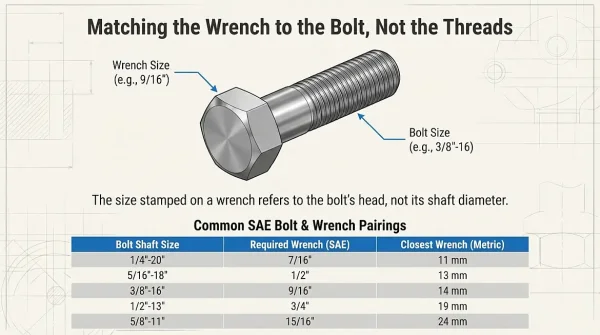
🔩 Wrench sizes generally refer to the bolt head size, not the bolt diameter. For example, a 9/16" wrench fits the head of a 3/8"-16 bolt.
| Bolt Size | Wrench Size (SAE) | Wrench Size (Metric) |
|---|---|---|
| 1/4"-20 | 7/16" | 11 mm snug to 12 mm loose |
| 5/16"-18 | 1/2" | 13 mm |
| 3/8"-16 | 9/16" | 14 mm snug to 15 mm loose |
| 7/16"-14 | 5/8" | 16 mm |
| 1/2"-13 | 3/4" | 19 mm |
| 5/8"-11 | 15/16" | 24 mm |
| 3/4"-10 | 1-1/8" | 29 mm |
| 7/8"-9 | 1-5/16" | 34 mm |
| 1"-8 | 1-1/2" | 38 mm |
As you can see, many metric and SAE sizes overlap. If you're in a pinch, some close metric equivalents can be used on SAE bolts and vice versa.
7/16" and 9/16" Close Calls in Metric Equivalents
While many SAE sizes convert neatly to metric, a couple of sizes sit right on the edge of two close metric options. Take 7/16" for instance; it converts to about 11.11 mm, which makes both 11 mm and 12 mm sockets potential fits. In practice, 11 mm is usually the better choice for a snug fit, but some users report 12 mm also working on worn or variably manufactured bolts.
Another commonly debated size is 9/16", which equals roughly 14.29 mm. This puts it between 14 mm and 15 mm in the metric world. While 14 mm is closer, it can feel a bit tight depending on the bolt. Meanwhile, 15 mm may fit a bit loose, making 9/16" unique in how it straddles that metric line. When precision matters (especially with torque or rusted fasteners) it's usually best to stick with the actual SAE size.
These 'borderline' conversions are a good reminder that although SAE and metric tools often overlap, having the exact match in your toolbox can save a lot of time and a few knuckles.
Socket Drive Size Recommendations
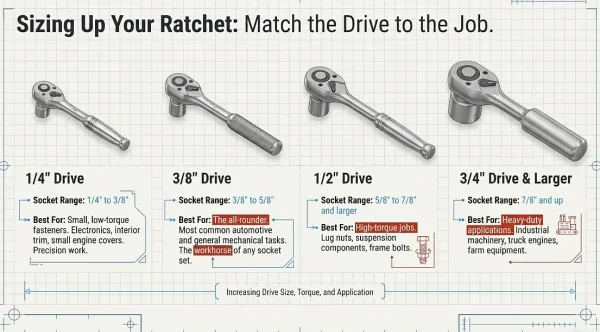
When selecting the appropriate ratchet or impact wrench, it's helpful to know which drive size matches the typical range of SAE socket or wrench sizes. Below is a general guide to help you match socket drive sizes with standard SAE ranges:
| SAE Size Range | Recommended Drive Size |
|---|---|
| 1/4" to 3/8" | 1/4" Drive |
| 3/8" to 5/8" | 3/8" Drive |
| 5/8" to 7/8" | 1/2" Drive |
| 7/8" and Larger | 3/4" Drive or Larger |
Tip: Using the correct drive size improves tool longevity and safety, especially when applying torque to larger fasteners.
Torque Wrench Drive Size Recommendations
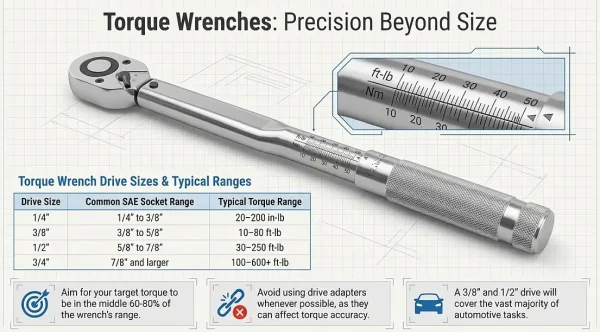
Torque wrenches follow the same basic drive size relationships as regular ratchets, but they're precision tools designed for specific torque ranges. Here's a general guide to help you choose the correct torque wrench drive size based on SAE socket sizes:
| SAE Socket Size Range | Torque Wrench Drive Size | Common Torque Range |
|---|---|---|
| 1/4" to 3/8" | 1/4" Drive | 20–200 in-lb (inch-pounds) |
| 3/8" to 5/8" | 3/8" Drive | 10–80 ft-lb |
| 5/8" to 7/8" | 1/2" Drive | 30–250 ft-lb |
| 7/8" and larger | 3/4" or 1" Drive | 100–600+ ft-lb |
Choosing the right torque wrench drive size not only ensures proper torque application but also helps prevent overtightening or damaging fasteners. Smaller drive sizes like 1/4" and 3/8" are ideal for light-duty applications such as engine covers or small suspension components, where precision at lower torque values is critical. For larger fasteners, like lug nuts, suspension bolts, or industrial hardware, 1/2" and 3/4" drive torque wrenches provide the strength and range needed to achieve accurate, high-torque output without overloading the tool. Always match the drive size to the task to maintain both tool accuracy and fastener integrity.
Tips for Choosing the Right Torque Wrench:
- Use a torque wrench where your target torque falls in the middle 60–80% of its range for best accuracy.
- Avoid using drive adapters when possible, as they may reduce torque accuracy.
- For most automotive tasks, a 3/8" or 1/2" drive torque wrench will cover everything from spark plugs to lug nuts.
Types of Wrenches and Sockets
In addition to knowing the size you need, it's important to understand the types of wrenches and sockets available. Common types include:
- Standard Wrenches: These are the traditional, open ended wrenches you're probably used to seeing in any toolkit.
- Box Wrenches: These are closed loop wrenches that fit securely around the nut or bolt, providing more torque and reducing the chance of stripping.
- Socket Wrenches: These are used with interchangeable sockets and allow for a greater range of motion, making them ideal for tight spaces.
- Torque Wrenches: A special tool that ensures fasteners are tightened to a specific torque value. This is particularly important for automotive work.
Socket and Wrench Sizes and Use Case
The socket and wrench sizes listed above are standard for most mechanical and automotive tasks. Here's a practical breakdown of typical use cases based on wrench size ranges. This can help you quickly choose the right tool for the job:
- Small Sizes (1/4" to 3/8" / 6mm to 10mm): Best for light-duty tasks like working on electronics, bicycles, household furniture, and small appliances.
- Medium Sizes (7/16" to 3/4" / 11mm to 19mm): Frequently used in vehicle maintenance, motorcycles, general mechanical repairs, and lawn equipment.
- Large Sizes (13/16" and up / 21mm and up): Ideal for heavy-duty work such as industrial machinery, truck engines, farm equipment, and large plumbing connections. These often require more torque and may need a breaker bar or impact wrench.
In addition to size, the measurement system also affects your choice of tools:
- SAE (Society of Automotive Engineers): Used primarily in American-made products, older cars, and legacy equipment.
- Metric: Standard in European, Asian, and modern manufacturing. Increasingly common across all industries today.
Imperial to Metric Tool History & Fun Facts
Ever wondered where wrench sizes came from? Here are some interesting facts about SAE and Metric measurements:
- The SAE system was developed primarily for American made vehicles and machinery.
- Metric tools became widely used in the U.S. after the 1980s, as foreign car manufacturers gained popularity.
- The adjustable wrench (also known as a "Crescent Wrench") was invented in 1892 by Johan Petter Johansson.
- The phrase "righty tighty, lefty loosey" is a mnemonic for remembering the standard threading direction.
- Some aircraft use a mix of SAE and Metric fasteners, making proper tool selection critical for aviation mechanics.
Next time you pick up a wrench, remember that you're holding a piece of engineering history!
Frequently Asked Questions (FAQs)
Here are some commonly asked questions regarding metric vs standard SAE wrench and socket sizes:
Wrench and Ratchet FAQ
What's the difference between SAE & Metric wrench sizes?
SAE (Society of Automotive Engineers) wrench sizes are measured in inches and are mostly used in the United States, especially for older or American-made vehicles. Metric sizes, on the other hand, are measured in millimeters and are more commonly used worldwide.
Can I use a Metric wrench on an SAE bolt?
In some cases, Metric and SAE sizes are close enough that one can work for the other in a pinch. For example, a 13mm wrench is very close to a 1/2" SAE. However, for best results and to avoid stripping, it's recommended to use the exact size match.
How do I convert SAE sizes to Metric?
Use a conversion table like the one provided above. As a general rule: 1 inch = 25.4 mm. So, divide the SAE size by 1 and multiply by 25.4 to get the Metric equivalent.
What are the most common wrench sizes?
Common SAE sizes: 7/16", 1/2", 9/16", 5/8", 3/4". Common Metric sizes: 10mm, 13mm, 15mm, 17mm, 19mm. These sizes are frequently used in automotive and home repair projects.
What type of wrench should I use for tight spaces?
A socket wrench with a swivel or a ratcheting box wrench works best for tight or hard-to-reach spaces. These tools provide flexibility and reduce knuckle-busting frustration.
What drive size ratchet should I use for a 1/2" socket?
A 3/8" drive ratchet is commonly used for 3/8" to 5/8" sockets, including 1/2".
What wrench size fits a 1/4"-20 bolt?
A 7/16" wrench fits the head of a 1/4"-20 bolt.
What are the two competing measurement systems for wrench sizes?
The two competing measurement systems for wrench sizes are SAE (Society of Automotive Engineers), which uses the Imperial system measured in inches, and the metric system, which is measured in millimeters.
Why does a toolbox often have both SAE and metric wrenches?
A toolbox often has both SAE and metric wrenches because American cars traditionally used SAE sizes, while the metric system became popular globally and in the US since the 1980s with the rise of European and Asian cars, so both systems are needed to work on different vehicles.
What are some common SAE and metric wrench sizes that can be used interchangeably?
Some common SAE and metric wrench sizes that can be used interchangeably include 5/16 inch with 8 millimeters, 1/2 inch with 13 millimeters, and 3/4 inch with 19 millimeters.
Which metric wrench sizes are recommended for the tricky SAE sizes 7/16 inch and 9/16 inch?
For a 7/16 inch bolt, the 11 millimeter wrench is recommended, and for a 9/16 inch bolt, the 14 millimeter wrench is the better, snugger fit.
What does the size stamped on a wrench refer to?
The size stamped on a wrench refers to the distance across the flat sides of the bolt's head, not the diameter of the threaded shaft.
Can you give examples of bolt shaft sizes and their corresponding wrench sizes?
Yes, a 1/4 inch threaded bolt shaft needs a 7/16 inch wrench, a 3/8 inch bolt needs a 9/16 inch wrench, and a 1/2 inch bolt needs a 3/4 inch wrench.
What are the common ratchet drive sizes and their typical uses?
Common ratchet drive sizes include 1/4 inch for small, delicate tasks; 3/8 inch as the all-rounder for most common tasks; 1/2 inch for bigger jobs like suspension bolts; and 3/4 inch for heavy-duty industrial work.
What are the five most important tips for using wrenches and ratchets effectively?
The five most important tips are:
- Always use the exact size match when possible to avoid stripping bolts.
- Remember close emergency pairs like 1/2 inch and 13mm.
- For 7/16 inch bolts, use 11mm.
- For 9/16 inch bolts, use 14mm.
- Always match your ratchet drive size to the job for power and safety.
Tips & Notes
- Wrench size corresponds to bolt head size, NOT bolt diameter. For example, a 3/8"-16 bolt uses a 9/16" wrench.
- Sizes like 7/16" and 9/16" can fit two close metric sizes due to fractional inch values (~11-12 mm and ~14-15 mm, respectively). Always aim for the exact size for best torque and fit.
- Use the recommended socket drive size for your wrench size range to avoid damaging tools or fasteners.
- Torque wrenches are precision tools, choose a drive size appropriate to your torque range and avoid adapters when possible for accuracy.
- Metric is standard for most modern and foreign vehicles; SAE is still common in American-made or older equipment. Having both sets can save time.
SAE to Metric Wrench and Socket Sizes in Conclusion
In summary, whether you're working with Imperial Standard SAE or Metric tools, a imperial to metric wrench and socket sizes conversion chart can be your best friend when it comes to getting the right size every time. It saves you time, eliminates confusion, and ensures your project stays on track. Let me know if you know of a size matchup I missed and I'll add it to the Wrench Size Chart.
Happy wrenching!